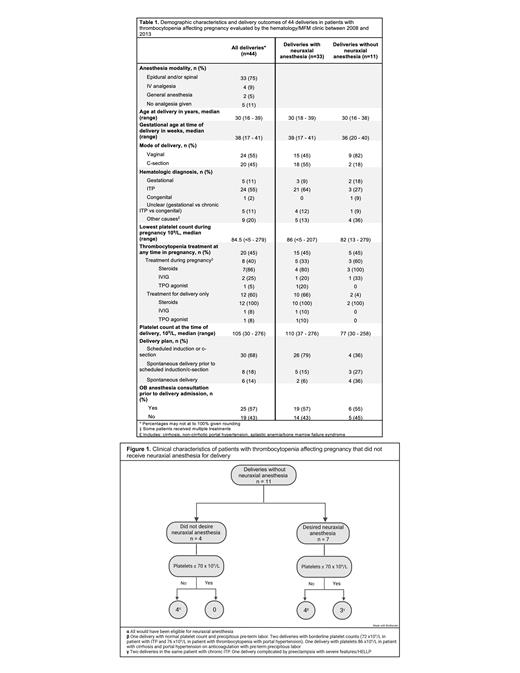Introduction: Thrombocytopenia, (platelets under 150x10 9/L) is observed in 10% of pregnancies with counts below 100x10 9/L seen in 1-2% (Reese et. al, 2018, Gernsheimer, 2012). Neuraxial anesthesia is an effective pain management strategy for vaginal delivery and a safe alternative to general anesthesia for c-section. Although the precise risk of spinal hematoma has not been established in this patient population, it remains a common barrier to neuraxial procedures (Bernstein et. al, 2016). The hematology/maternal fetal medicine clinic (MFM) was created in our academic institution in February 2018 in response to the need to provide multidisciplinary care to patients with hematologic disorders in the context of pregnancy, including those with thrombocytopenia.
Objectives: To establish the rate of neuraxial anesthesia in patients with thrombocytopenia seen in the multidisciplinary hematology/MFM clinic in our academic institution between 2018 and 2023 and identify clinical characteristics and practice patterns that affect the ability of this patient cohort to receive neuraxial procedures.
Methods: Medical charts from all patients with thrombocytopenia affecting pregnancy evaluated in the hematology/MFM clinic (n=40 patients) were retrospectively reviewed. Baseline demographics, laboratory values, medical interventions (platelets directed treatment, neuraxial anesthesia, delivery route) and delivery outcomes were captured and analyzed using descriptive statistics (Table 1).
Results: 40 patients underwent 44 deliveries. 33 (75%) were able to receive neuraxial anesthesia for delivery (15 vaginal and 18 c-section) ( Table 1) The median platelet count at the time of delivery was 105x10 9/L with 30 of 33 of the neuraxial deliveries occurring with platelet counts greater than 70x10 9/L (threshold recommended by the SOAP consensus (Bauer et. al, 2021)). The median platelet count at time of delivery for those who received neuraxial anesthesia was higher than for those who did not receive neuraxial (110x10 9/L vs 77x10 9/L). Rates of platelet directed treatment were similar in all patients independent of whether they received neuraxial anesthesia. Overall patients that did not receive neuraxial anesthesia delivered earlier and many delivered prior to their scheduled date. Despite the hematology/MFM clinic facilitating OB anesthesia consultations, a large proportion of patients were not evaluated prior to admission for delivery. Of the 11 patients that did not receive neuraxial anesthesia, 4 did not desire it, but would have been eligible based on their platelet counts at delivery ( Figure 1).
Conclusions: These preliminary results indicate that a multidisciplinary approach can effectively treat thrombocytopenia in pregnant people and enable them to receive desired neuraxial anesthesia. Pre-term labor, precipitous delivery, and medical complications of pregnancy remain challenges to pregnant patients receiving neuraxial anesthesia. Future directions include examining which clinical interventions facilitate neuraxial anesthesia for pregnant patients in a larger population.
Disclosures
No relevant conflicts of interest to declare.


